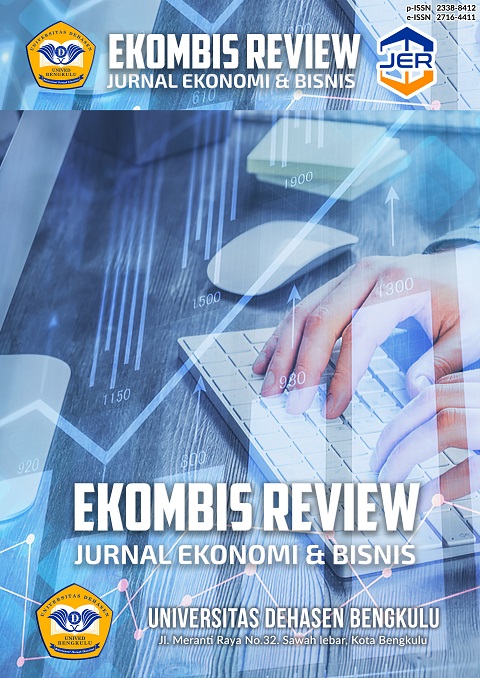Pengaruh Fraud Diamond Terhadap Kecurangan Laporan Keuangan Perusahaan Sektor Industri Barang Konsumsi yang Terdaftar di Bursa Efek Indonesia Tahun 2016-2020
Abstract
This study aims to obtain empirical evidence regarding the effect of fraud theory on financial statements as measured using the F-Score method. The novelty of this research is the use of eight variables in this study to find out more specifically from the financial statements. This study uses the fraud diamond theory and agency theory. The population of this study consists of industrial goods and consumption companies listed on the Indonesia Stock Exchange. The population of this study consists of companies located in Indonesia. The research period is 2016 to 2020. The data used in this study is secondary data obtained from the company's annual financial statements. Purposive sampling technique was used to determine the research sample. There are 35 companies that are sampled. Factor analysis and logistic regression analysis methods were used as research methods. Based on the results of the study that ROA, RECEIV, BDOUT, AUDCHAGE, have a positive effect on the financial reporting of industrial and consumer goods companies listed on the Indonesia Stock Exchange. Furthermore, ACHANGE, LEV, AUDIT OPINION, DCHANGE have no effect on the financial statements of industrial and consumer goods companies listed on the Indonesia Stock Exchange.
Downloads
References
Agustina, R. D., & Pratomo, D. (2019). Pengaruh Fraud Pentagon Dalam Mendeteksi Kecurangan Pelaporan Keuangan. Jurnal Ilmiah Manajemen, Ekonomi, & Akuntansi (MEA), 3(1), 44–62. https://doi.org/10.31955/mea.vol3.iss1.pp44-62
Albrecht, C., Holland, D., Malagueno, R., Dolan, S., & Tsafrir, S. (2015). The Role of Power in Financial Statement Fraud Schemes. Journal of Business Ethics 131 : 803-813.
Dechow, P. M., Ge, W., Larson, C. R., & Sloan, R. . (2011). “Predicting material accounting misstatements.” Contemporary Accounting 28 (1): 17–82.
Ghazali, I. (2018). Aplikasi Analisis Multivariate dengan Program IBM SPSS 25. Badan Penerbit Universitas Diponegoro: Semarang.
Ginting, J., Jumiadi, A. W., & ... (2021). Fraud Detection Analysis Of Presentation Of Financial Statements Of Property And Real Estate Companies On The Indonesia Stock Exchange, 2018-2019. … Journal of Economic …, 1(1), 368–387. http://jurnal.ceredindonesia.or.id/index.php/injects/article/view/455
Khoirunnisa, A., Rahmawaty, A., & Yasin, Y. (2020). Fraud Pentagon Theory dalam Mendeteksi Fraudulent Financial Reporting Pada Perusahaan yang Terdaftar di Jakarta Islamic Index 70 (JII 70) Tahun 2018. BISNIS : Jurnal Bisnis Dan Manajemen Islam, 8(1), 97–110. https://doi.org/10.21043/bisnis.v8i1.7381
Nurbaiti, A., & Suatkab, N. (2019). Fraud Diamond Analysis in Detecting Fraudulent Financial Statement. Jurnal Manajemen Indonesia, 19(2), 186. https://doi.org/10.25124/jmi.v19i2.1922
Nurwulandari, A., & Darwin, M. (2020). Heywood Case Data Statistics : Using The Model Respesification Technique. Nucleus, 74–84. https://doi.org/https://doi.org/10.37010/nuc.v1i2.173
Prasmaulida, S. (2016). Financial Statement Fraud Detection Using Perspective of Fraud Triangle Adopted By Sas No. 99. Asia Pacific Fraud Journal, 1(2), 317. https://doi.org/10.21532/apfj.001.16.01.02.24
Puspitadewi, E., & Sormin, P. (2018). Pengaruh Fraud Diamond Dalam Mendeteksi Financial Statement Fraud. Jurnal Akuntansi, 12(2), 146–162. https://doi.org/10.25170/jara.v12i2.86
Situngkir, N. C. (2020). Detecting Fraudulent Financial Reporting Using Fraud Score Model and Fraud Pentagon Theory : Empirical Study of Companies Listed in the L . Q . 45 Index. 23(3), 373–410. https://doi.org/10.33312/ijar.486
Triyanto, D. N. (2019). Detection of Financial Reporting Fraud: The Case of Socially Responsible Firms. Journal of Economics, 22(3), 399–410. https://doi.org/10.14414/jebav.v22i3.1792
Wolfe, D. T., & Hermanson, D. R. (2004). The Fraud Diamond: Considering The Four Element of Fraud. CPA Journal. 74.12: 38-42. The Fraud Diamond: Considering The Four Elements of Fraud. The New York State Society of CPAs.
Wolfe dan Hermanson. (2004). Fraud Diamond merupakan penyempurnaan dari teori Fraud Triangle dengan persamaan variabel yaitu tekanan, kesempatan, dan rasionalisasi. Penambahan satu variabel dalam teori ini yaitu Capability. Web.
Yesiariani, M., & Rahayu, I. (2016). ANALISIS FRAUD DIAMOND DALAM MENDETEKSI ( Studi Empiris pada Perusahaan LQ-45 yang Terdaftar di Bursa Efek Indonesia Tahun 2010 - 2014 ). Simposium Nasional Akuntansi XIX, Lampung, 1–22.
Copyright (c) 2022 Banin Ufiana, Dedik Nur Triyanto

This work is licensed under a Creative Commons Attribution-ShareAlike 4.0 International License.
An author who publishes in the EKOMBIS REVIEW: Jurnal Ilmiah Ekonomi dan Bisnis agrees to the following terms:
Author retains the copyright and grants the journal the right of first publication of the work simultaneously licensed under the Creative Commons Attribution-ShareAlike 4.0 License that allows others to share the work with an acknowledgement of the work's authorship and initial publication in this journal
Submission of a manuscript implies that the submitted work has not been published before (except as part of a thesis or report, or abstract); that it is not under consideration for publication elsewhere; that its publication has been approved by all co-authors. If and when the manuscript is accepted for publication, the author(s) still hold the copyright and retain publishing rights without restrictions. For the new invention, authors are suggested to manage its patent before published. The license type is CC-BY-SA 4.0.
EKOMBIS REVIEW: Jurnal Ilmiah Ekonomi dan Bisnis is licensed under a Creative Commons Attribution-ShareAlike 4.0 International License.














